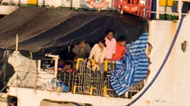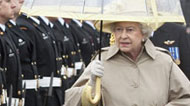On Monday, June 21 and Tuesday, June 22, The National takes viewers inside the country's spy agency, the Canadian Security Intelligence Service (CSIS), for a rare look into its highly-secretive counterterrorism and counterespionage activities.
Read about the challenges of filming at CSIS headquarters
This entry was posted by CBC News The National producer Marc Baby.
We knew from the start that our spy agency would be camera-shy.
The Canadian Security and Intelligence Service is, after all, a secret organization doing classified work, charged with protecting Canada’s national security and interests. They are up against a world of spies who would like nothing better than to get glimpses of who works for CSIS and how it operates, in order to potentially infiltrate them or thwart their efforts at fighting terrorism and espionage. Over the course of their 25-year-plus history, they have remained largely hidden in the shadows. So while they allowed us inside their headquarters and regional offices with television cameras for the first time ever, there were lots of restrictions on and lots of negotiations about what we could and couldn’t film. Many doors remained closed to us, and it made for a challenging time for our production team.
Perhaps the most problematic restriction involves what CSIS considers its most valuable asset - its people. With a few exceptions, those who work there can’t be filmed. To identify them publicly is to blow their cover and destroy their ability to do their jobs. But we needed visuals to be able to talk about what they do. Filming staff was tricky. We had to shoot lots of close-ups, where you see hands and feet, but not faces. When we interviewed Intelligence Officer “Christina” (not her real name), a CSIS veteran, we had to film her in silhouette and alter her voice.
For a generally inward-looking organization, CSIS’s headquarters is surprisingly open and airy. However, even in their common areas, we weren’t allowed to film anytime there was staff walking through, which was often. When we tried to film staff using walkways between floors and in silhouette, CSIS nixed several shots because they said the people were identifiable by the shapes of their bodies.
There were some areas of CSIS’s operations that we weren’t allowed any access to at all. The Integrated Threat Assessment Centre (ITAC), inside which CSIS agents and various police forces bring together intelligence and analysis to inform the Government of Canada of potential threats, was off limits - too sensitive. Certain areas, like the forensic laboratory, had curtains concealing activities we were not allowed to see.
Even the smallest items were restricted. Whether it was a family photo adorning a desk that our camera could catch, or a glimpse of someone’s face, CSIS made sure we couldn’t film it.
We were not allowed to film any part of their security systems. At one point, we were filming staff entering the building, just taking close-up shots that would not identify anyone. Our CSIS escort approved the shots before we filmed them, but hours later, they called us into a meeting room and said those shots were unacceptable. You could see the colour of the entry cards as they swiped in. Those shots will never air.
CSIS staff also kept a close eye on us at all times. We were escorted everywhere, including our visits to the washroom (they waited outside). You can’t enter or leave the building without an escort.
Cellphones must be surrendered to CSIS security staff as you enter the building. No transmitters are allowed, of any kind. That rule affected some of our normal production gear. We tend to use wireless microphones in the field, equipped with transmitters that send the signal back to the camera. CSIS does not allow any wireless transmitters inside, so we had to hard-wire our sound gear to the camera. This made working inside much more challenging and time consuming for us.
Paranoid? Possibly. But CSIS is a target for all sorts of nefarious foreign agents, who themselves are targeted by CSIS. Infiltration is a very real concern, and preventing the bad guys from learning about CSIS’s operations is paramount to their continued operations. Since its inception, CSIS has preferred to stay out of the spotlight and away from the camera’s prying eye. This year, they opened up and let us in, because Director Richard Fadden believes the culture of secrecy may have gone too far and needs to change somewhat. But they still kept many secrets locked up tight.






